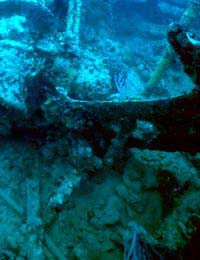
On a terrestrial site, analysis of the artefacts may take up to eighteen months, while the excavation of them may only have taken as little as a few weeks. Similarly, in underwater archaeology, the conservation of relics takes a proportionally much longer time than the recovery of them from their watery home. Conservation of waterlogged and encrusted objects is both time consuming and expensive. Specialised laboratories are essential in the preservation of artefacts that have endured a lengthy immersion in salt or fresh water.
Artefacts that have been subject to long periods of water immersion will react chemically to the solution or products around them. For instance, metal objects such as those of iron or brass will react with the water surrounding them or the sediments in which they are buried. A rapid removal from this environment will expose them to the air and numerous chemical reactions can occur that may even destroy the item.
Ships of Wood and Iron
Other than pottery items such as plates, jugs and storage jars, or lithic objects such as stone anchors and ballast weights, there are usually few other artefacts made of stone or pottery. Most shipbuilding materials were wood and some form of metal usually iron and brass. However, unlike pottery and stone, these nautical building materials can decay rapidly when immersed. Sometimes, artefacts are buried in anaerobic sand. This can often preserve soft organic materials like wood and fibre.
Encrustation
Many artefacts are recovered from the seabed fully enveloped with thick encrustation. The novice might chip away at the covering in an attempt to expose the valuable relic within only to find that there is literally, nothing there.
When a metal item is immersed in seawater the surrounding environment quickly covers it in a hard crusty shell. Over time this encrustation thickens but chemical reactions inside, slowly decay the original object, sometimes dissolving it completely. What remains is a hollow impression or mould in the shape of the original. Although the object is gone it can be remade my carefully filling the cavity with epoxy resin. This must be done with exacting care because when the encrusted mould is broken open to retrieve the casting it usually damages the mould sufficient to make it unsuitable for further castings.
Likely encrustations are x-rayed to see what is within them. The radiologist is searching for metal remains within the encrustation. If an artefact is found to be sound it can be sent for cleaning to another specialist. If the radiologist suspects that the original has been dissolved leaving only a mould then further analysis by ultra-sound will be necessary to confirm if a resin replica can be made.
Wooden Artefacts
Replacing the saturated water with silicone oil can conserve wooden objects and soft organic artefacts like ropes and clothing. If professional staff and/or proper facilities and equipment are not available then it is preferred for all organic remains to be left in situ.
Bones
Skeletal remains always seem to fascinate and interest the public. Conservation of submerged bone poses greater challenges for the osteologist. Bone is porous and if submerged in seawater for a long time it can absorb soluble salts that will destabilise the bone. To remove the salts experts wash the bones using de-ionised water then immerse them in repetitive baths of ethanol and acetone. Bone that cannot be immediately treated can be stored in a diluted ethanol bath.
The conservation of submerged objects for scientific study, analysis and subsequent display for the public to view is a long, costly process undertaken by dedicated conservators. From when a relic first surfaces it can take as much as ten years before it is processed for public display.